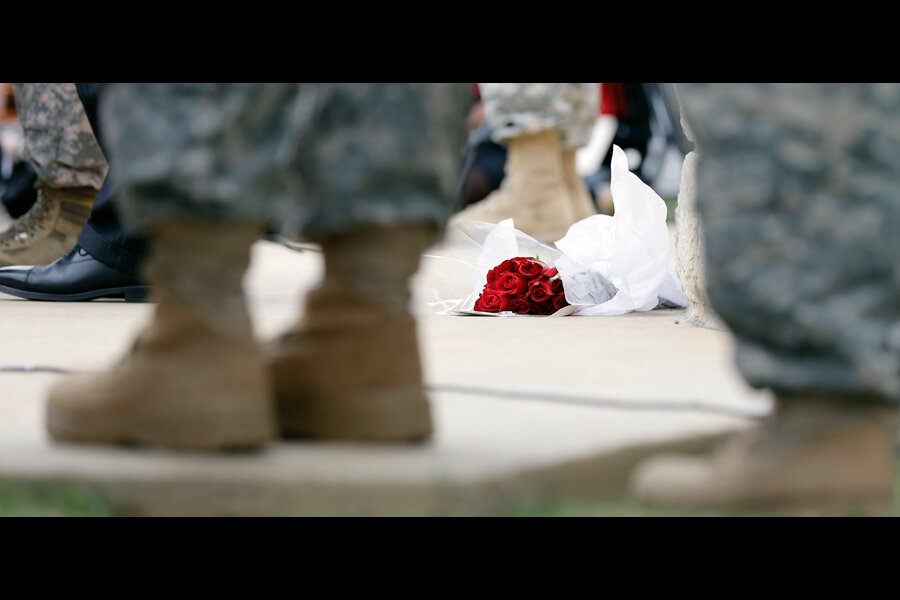Fort Hood shooting: Is Army paying enough attention to mental health?
Loading...
| Washington
In the days before going on a shooting rampage that would take the lives of three people and leave more than a dozen others wounded Specialist Ivan Lopez was “under diagnosis” for post-traumatic stress disorder, “but he had not yet been diagnosed,” the senior officer at Fort Hood, Texas, said Thursday.
So how long does that take, exactly, to diagnose post-traumatic stress disorder? And does the fact that he was undiagnosed – after what US officials describe as a history of "psychiatric instability” – mean that the military failed to heed the lessons of some of its most recent tragedies?
The most notable of these is the Fort Hood shootings of 2009, in which 13 people were killed. An investigation published afterward found that Defense Department programs that address indicators for violence “are outdated, incomplete, and fail to include key indicators of potentially violent behaviors.”
On the heels of the second such violent attack in five years by a service member at the base, there is “very strong evidence” that Specialist Lopez had an “unstable psychiatric history,” Lt. Gen. Mark Milley, commander of the soldiers at Fort Hood, said at a press conference Thursday.
Hours earlier, at a hearing on Capitol Hill, Secretary of the Army John McHugh noted that while the Army is “trying to keep an eye” on the mental health of its soldiers, “clearly we believe there are more things we can do” to identify problems that “under our current tool kit may not be so obvious.”
Today, soldiers who are preparing to go to war are evaluated 180 days, 90 days, and 30 days before they deploy, as well as 30 and 90 days after return – and then annually after that, Secretary McHugh told lawmakers.
This presumes that when soldiers suffer mental anguish, it tends to be caused by experiences in combat. But a groundbreaking study published by the Journal of the American Medical Association (JAMA) last month found that more than three quarters of troops who say that they grapple with mental illness report that they have been doing so long before joining the military.
In turn, more than half of all suicide attempts among soldiers trace back not to combat, but to pre-enlistment mental health struggles, the study found.
While Lopez served for four months in Iraq as a truck driver, there is no indication he saw combat or sustained any physical injuries, military officials say, adding that like many of the soldiers in the study, he had been grappling with his mental health for some time.
It is clear that the Army medical system had identified him as a person with mental health problems. “He was in the system and he was being looked at,” Lt. Gen. Milley said.
Yet a diagnosis of post-traumatic stress disorder (PTSD) doesn’t take too long, most mental health professionals agree.
“We can usually determine if symptoms are there in one hour-long session,” says Harry Croft, a former Army physician who has done PTSD evaluations of more than 7,000 veterans and says the vast majority of those diagnosed do not behave violently.
That said, in the military a PTSD diagnosis can be more complicated because it can be a career ender, Dr. Croft adds, since the diagnosis might result in the suspension of someone’s security clearance.
There are also “deployment factors in the military,” he says.
Veterans advocacy groups say they worry that some of these “deployment factors” may mean that the Army has one policy – to de-stigmatize and treat PTSD – but that commanders may have different interests.
In a report to be published in May, called “Operation Recovery: Testimony from Fort Hood,” the organization Iraq Veterans Against the War concludes that “commanders were regularly overriding medical recommendations for service members with PTSD not to deploy,” says Matt Howard, an Iraq war veteran and communications director for the group.
Instead, he says, the military medical system seems to “overprescribe medications as a band-aid.”
Milley told reporters that Lopez was taking the drug Ambien, which is prescribed for sleep trouble.
“I think it’s revealing that this person is getting medication, but he hasn’t received a diagnosis,” says Mr. Howard, who in arguing his charge of the over-medication of soldiers points to the drive-through pharmacy on Fort Hood, which has three lanes.
Of equal concern, he says, is what will happen to soldiers struggling with mental health issues as the Army begins to reduce its ranks after 12 years of war.
If the soldiers with “personality disorders” are the first ones to go, he asks, will they be deemed “too expensive to fix – like an old car”?
Military officials stress that they are committed to caring for the veterans of America’s longest wars. But Gen. Raymond Odierno, the Army chief of staff, told lawmakers Thursday that he worries about the inverse, too: As the military draws down, will it put more stress on the soldiers who stay on?
“In the future, if we have to deploy these forces, it’s going to put significant risk on them, because of their numbers,” he said.
For now, military officials and lawmakers say they will continue to search for answers.
“Obviously we’re digging deep into his background, any criminal history, psychiatric history, his experiences in combat – all of the things that you would expect us to be doing are being done right now,” Milley said of Lopez.
And lawmakers say they will be watching closely.
“There will be a thorough review,” said Sen. John Cornyn (R) of Texas, who stood beside Milley at the press conference Thursday. Mental health “is one of the most vexing but also one of the most urgent issues.”
Debate about how best to treat mentally wounded soldiers “is one that’s been ongoing for at least the last 13 years,” he said. “It’s not going to abate. My sense is that it’s going to accelerate.”





